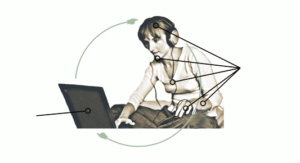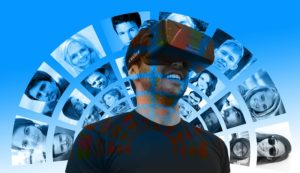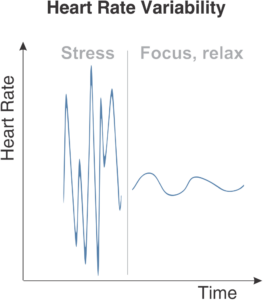Virtual reality biofeedback and anxiety: Check out virtual reality biofeedback interventions if you are looking for a new way to treat your anxiety. This type of treatment is still relatively new, but it effectively manages stress and anxiety. Read on to learn more about virtual reality biofeedback interventions and how they might help you.
Table of Contents
Anxiety disorder prevalence and pattern
 Anxiety disorders are the most common mental health problem in the United States, affecting 40 million adults in the US each year. The global prevalence of anxiety disorders is 7.3%, ranging from 5.3% in African nations to 10.4% in European/Anglo countries. Symptoms of anxiety disorders include:
Anxiety disorders are the most common mental health problem in the United States, affecting 40 million adults in the US each year. The global prevalence of anxiety disorders is 7.3%, ranging from 5.3% in African nations to 10.4% in European/Anglo countries. Symptoms of anxiety disorders include:
- Dread of losing control
- Scary thoughts, poor attention, and
- Hypervigilance for dangers.
Increased heart rate, blood pressure, palpitations, light-headedness, hot flushes, and stomach ache are typical. Anxiety disorders can cause avoidance of (perceived) threats, restlessness, hyperventilation, and a desire for reassurance.
While many treatments are available, such as medication and therapy, some people do not respond well to traditional therapies. Virtual reality biofeedback interventions offer a new treatment option for people with anxiety disorders that may be more effective than traditional treatments.
In virtual reality biofeedback interventions, patients learn to control their emotions by watching a computer-generated environment change in response to their emotional state. This intervention is effective for treating anxiety disorders and may be a promising new treatment option for people who do not respond well to traditional treatments.
Stress, Autonomic Nervous System and Heart Rate Variability
It is essential to understand how the autonomic nervous system, heart rate, and stress interact to maintain a healthy cardiovascular system. The autonomic nervous system controls heartbeat deceleration and acceleration via the vagus nerve. The sympathetic nervous system is activated in times of stress, which increases heart rate.
High heart rate variability (HRV) is linked with a healthy cardiovascular system, paralleling the flexibility of the ANS. Reduced HRV is connected to autonomic dysregulation. Therefore, it is crucial to manage stress levels and understand the interactions between the autonomic nervous system and heart rate to maintain a healthy cardiovascular system. Biofeedback helps in the process of ANS modulation.
Biofeedback as a Treatment for Anxiety Disorders
Anxiety disorders are treated with SSRIs or benzodiazepines to relieve tension and dread [48]. The most effective and studied techniques, psychotherapy and cognitive-behavioral therapy (CBT) are often utilized in anxiety disorders. Biofeedback is another potential anxiety disorder therapy.
What is biofeedback?
 Biofeedback is a treatment that uses sensors to measure a patient’s mind and body functions, such as heart rate, skin temperature, blood pressure, brain activity, and muscle tension. The patient can then see their results in real-time and learn how to control them. This can be done through relaxation techniques or other means.
Biofeedback is a treatment that uses sensors to measure a patient’s mind and body functions, such as heart rate, skin temperature, blood pressure, brain activity, and muscle tension. The patient can then see their results in real-time and learn how to control them. This can be done through relaxation techniques or other means.
Biofeedback is an effective treatment for anxiety disorders, especially when combined with cognitive-behavioral therapy.
How does biofeedback work?
Biofeedback works by teaching the patient to control their body’s response to stress. When someone is experiencing anxiety, their body goes into “fight-or-flight” mode. This means that the heart rate increases, breathing quickens, and blood pressure rises.
Biofeedback helps the patient identify when their body is going into this fight-or-flight mode and then teaches them how to control it. This can be done through relaxation techniques, such as deep breathing or progressive muscle relaxation.
Who can benefit from biofeedback?
Biofeedback can treat various anxiety disorders, including generalized anxiety disorder, panic disorder, social anxiety disorder, and posttraumatic stress disorder.
Biofeedback may also be helpful for people who experience anxiety as a result of another condition, such as chronic pain or migraines.
What are the risks of biofeedback?
Biofeedback is generally safe, and there are no known side effects. However, as with any treatment, there is a risk that the patient may not respond well to the therapy.
It is important to note that biofeedback should not be a standalone treatment for anxiety disorders. Instead, it should be used with other treatments, such as medication and psychotherapy.
Biofeedback uses biosensors, such as electrodes, to show a client’s physiological reactions in real-time. It induces interoceptive self-regulation, which is generally unconscious. Autonomic mechanisms for anxiety disorder therapy include electrodermal activity (EDA), HR, HRV, and respiratory feedback. Operant control modifies physiological processes based on these cues (e.g., intonation or vision). HRV reduces stress and anxiety.
What is virtual reality biofeedback?
 Virtual reality biofeedback (VRB) is a type of therapy that uses virtual reality technology to help people with anxiety disorders. VRB can provide people with a way to confront their fears in a safe and controlled environment.
Virtual reality biofeedback (VRB) is a type of therapy that uses virtual reality technology to help people with anxiety disorders. VRB can provide people with a way to confront their fears in a safe and controlled environment.
How does VRB work?
During VRB, people wear a headset that immerses them in a virtual environment. While in the virtual environment, people are exposed to things that may trigger their anxiety, such as heights or public speaking. The exposure is usually done gradually so that people can learn to cope with their anxiety triggers.
VRB can help people with anxiety disorders by:
- Allowing them to confront their fears in a safe and controlled environment
- Helping them to learn new skills to cope with their anxiety triggers
- Providing them with a way to practice these skills in a safe and controlled environment
- Allowing them to feel less anxious and more confident in their ability to cope with their anxiety triggers.
VRB is a promising new treatment for anxiety disorders, and more research is needed to determine its effectiveness. However, VRB may not be suitable for everyone, so it is crucial to speak with a mental health professional before starting this type of therapy.
The Effect of VR on Anxiety
VR is added to a modern kind of biofeedback for anxiety problems. Various research indicated that VR might replicate disturbing stimuli and elicit anxiety, physiological, and subjective stress equivalent to real-life exposure. Virtual exposure treatment showed similar effects to in vivo phobia exposure or in sensu PTSD exposure. Virtual characters (avatars) can give excellent social support in the face of a confirmed stressor in this kind of exposure therapy [28]. VR can be utilized for game-based techniques in child and adolescent therapy.
These studies of the use of VR in the treatment of anxiety disorders showed that VR is a promising treatment option for anxiety disorders, with a large effect size for specific phobias and moderate effect size for social anxiety disorder. The authors concluded that more research is needed to determine the long-term effectiveness of VR therapy for anxiety disorders.
One of the most common applications of VR in the treatment of anxiety is virtual reality exposure therapy (VRET). VRET is a cognitive-behavioral therapy that uses VR technology to expose people to their fears in a safe and controlled environment. VRET is an effective treatment for anxiety disorders, including specific phobias, social anxiety disorder, and posttraumatic stress disorder.
Virtual Reality Biofeedback Evidence Base
Kothgassner and colleagues published a meta-analysis of seven randomized controlled trials examining the effects of virtual reality biofeedback on anxiety.
They found that several challenges may restrict classic biofeedback’s usefulness and effectiveness for treating anxiety disorders, such as keeping up patient motivation and engagement levels. The biofeedback process requires that patients be comfortable with monitoring their physiology, which can be daunting for some. In addition, the process can be time-consuming and expensive, which may limit its appeal to many people. Finally, it is vital to have a skilled practitioner to guide the process, making it difficult to access for those who live in rural areas or do not have health insurance. Classic biofeedback remains a promising treatment option for those suffering from anxiety disorders despite these challenges.
VR is an effective tool in exposure therapy, a type of psychotherapy used to treat anxiety disorders. VR can be used to boost motivation and engagement levels in various activities.
 For example, VR can create virtual environments that simulate real-world situations, which can help people become more motivated to engage in these activities. VR also has gamification components that can make activities more enjoyable and engaging. For instance, VR games can reward people for completing tasks or reaching specific goals. These features make VR an attractive option for people looking for new ways to boost their motivation levels to combat their anxiety.
For example, VR can create virtual environments that simulate real-world situations, which can help people become more motivated to engage in these activities. VR also has gamification components that can make activities more enjoyable and engaging. For instance, VR games can reward people for completing tasks or reaching specific goals. These features make VR an attractive option for people looking for new ways to boost their motivation levels to combat their anxiety.
Furthermore, the immersive nature of VR can help to reduce distractions and increase attentional focus, making it easier for people to relax and focus on their treatment. Additionally, the use of VR gear in therapy can help to improve social skills and reduce anxiety related to social interactions. As VR technology evolves, it may become an increasingly popular and effective treatment for anxiety disorders.
Safety and feasibility information
Kothgassner and colleagues found that VR with biofeedback is practical and satisfying for people with anxiety disorders, pain, and surgical patients. They recommended that future studies investigate VR biofeedback’s usefulness in various populations and scenarios.
Some populations that may benefit from VR biofeedback include those with posttraumatic stress disorder (PTSD), phantom limb pain, eating disorders, and substance abuse disorders. Additionally, VR biofeedback may be helpful in people who are undergoing medical procedures such as childbirth, cancer treatment, or surgery.
Finally, VR biofeedback may also be beneficial for people trying to quit smoking or lose weight. By providing individuals with real-time feedback about their physiological responses, VR biofeedback has the potential to help people change their behaviors and improve their health.
One of the studies in Kothgassner and colleagues’ review showed that patients found the mobile biofeedback app effective in reducing their symptoms. The app was well-tolerated and showed that patients had an improvement in symptoms. This suggests that mobile biofeedback may be a valuable addition to traditional biofeedback methods. APPs that are gamified may help to engage and motivate patients even more. Using smartphone APPS and wearables can help to reach a more significant number of patients who may not be able to access traditional biofeedback methods.
Most studies of VR as a biofeedback tool haven’t found any harmful effects, with insufficient evidence about its safety. Some people have had problems with motion sickness, which can cause nausea, vomiting, and vertigo. Therefore, there is a need for more research to determine if there are any other risks or side effects associated with using VR as a biofeedback tool.
The benefits of virtual reality biofeedback for therapy
The benefits of virtual reality biofeedback for anxiety and other issues have been shown in several studies. VR seems to be more effective than traditional 2D biofeedback, with less distraction and mind wandering. However, these effects have only been shown in a single session. More research is needed to determine if they are stable over time.
The positive effects of VR biofeedback were limited to heart rate (HR) and subjective anxiety. However, it is unclear why this was the case. In contrast, RMSSD (Root mean square of successive RR interval differences) did not show any changes in the respective studies; however, a recent review has highlighted the importance of HRV concerning emotional well-being.
 Higher HRV levels were associated with greater emotional satisfaction and lower anxiety, worry, and ruminating levels. Regarding health promotion, it is proposed that coherent breathing stimulates high-amplitude oscillations that eventually impact brain rhythmicity, particularly in areas involved in emotion regulation.
Higher HRV levels were associated with greater emotional satisfaction and lower anxiety, worry, and ruminating levels. Regarding health promotion, it is proposed that coherent breathing stimulates high-amplitude oscillations that eventually impact brain rhythmicity, particularly in areas involved in emotion regulation.
The effectiveness of HRV has several clinical and behavioural implications for anxiety sufferers. Reduced resting HRV has been associated with social interaction anxiety, and this means that people who suffer from this type of anxiety have a lower resting heart rate. Interestingly, in women, lower RMSSD scores (a measure of HRV) during an emotion detection test were related to greater recognition accuracy in women with greater social anxiety symptoms.
In men, a higher vagal tone (another measure of HRV) improved cooperative social behaviour. Therefore, HRV can positively affect both social interaction and emotions in people suffering from anxiety.
Future research is needed to see if virtual settings and biofeedback protocols are more successful in increasing parasympathetic tone. It has been shown that funny stimuli can elicit parasympathetic responses, so the content of VR biofeedback interventions might be modified accordingly.
Conclusion
Virtual Reality (VR) is a technology that has been around for a few decades, but it is only recently that its potential as a biofeedback tool has been explored. VR can provide individuals with real-time feedback about their physiological responses, which has the potential to help people change their behaviors and improve their health. Several studies have shown that VR biofeedback effectively reduces anxiety and heart rate, and there is also evidence to suggest that it can be used to increase parasympathetic tone. Future research should explore the long-term effects of VR biofeedback and investigate whether it can be used to treat other conditions effectively.
References
The work of Kothgassner and colleagues inspired this article: Kothgassner, O.D., Goreis, A., Bauda, I. et al. Virtual reality biofeedback interventions for treating anxiety. Wien Klin Wochenschr134, 49–59 (2022). https://doi.org/10.1007/s00508-021-01991-z




